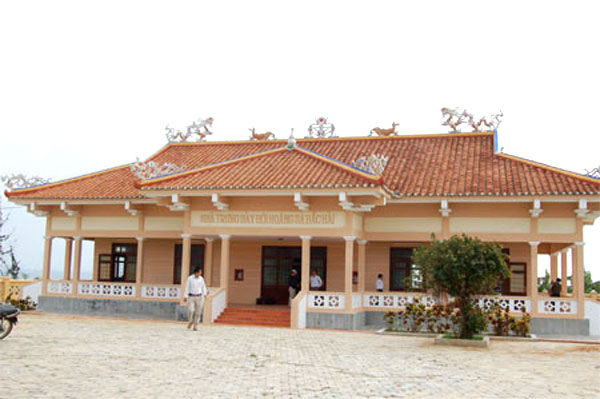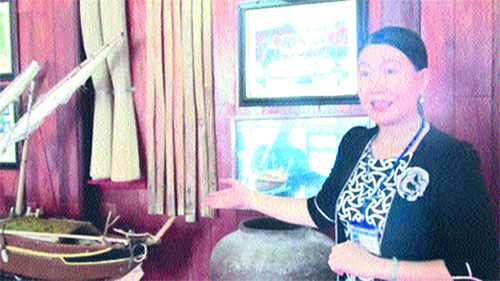Guide gushes about Hoang Sa history
A woman whose ancestor patrolled the Hoang Sa (Paracels) Islands hundreds of years ago tells foreign and local museum visitors historical tales about the area. Nam Cuong and Trung Hieu report.
A woman museum guide loves Hoang Sa (Paracels) Islands' history so much that she can talk about it all year round without being bored.
Dang Thi Hien is young, good-looking, and has a voice mellifluous enough to attract tourists, both domestic and foreign.
She can talk about Hoang Sa Islands [which have been totally invaded by China since 1974] all day, in fact, every single day of the year, and will still be left with a lot more to say. Such is her passion about national history.
Hien is a museum guide at the Hoang Sa - Bac Hai Museum in the Ly Son Island, off the coast of the central province of Quang Ngai.
 |
|
House of heritage: The Museum of Hoang Sa - Bac Hai in the Ly Son Island District of Quang Ngai Province. |
A 15th generation descendant of Dang Van Siem, a sailor who was sent by the Nguyen dynasty (1802-1945) to patrol and protect Hoang Sa hundreds of years ago, Hien says she feels a sense of pride everytime she speaks about Hoang Sa.
Having graduated in tourism business from a HCM City university six years ago, Hien returned to her home in Ly Son Island District at the time when the museum was being completed.
She applied for a job at the district's Culture - Information Office with the aim to be a guide at the museum.
"Working here, I can talk about Hoang Sa, talk about the achievements and sacrifices of our ancestors in the archipelago from hundreds of years ago," Hien said.
"The groups of foreign visitors who arrive in Ly Son Island often have their own interpreters. However, when I talk about Hoang Sa archipelago, about our sea and island sovereignty, and our history, their translation sometimes lacks the appropriate words.
"I do hope that the interpreters, when translating for the benefit of foreign tourists, should learn more about Hoang Sa and Truong Sa (Spratlys) archipelagos."
Originally, the museum had only a precious asset that was the decree which belonged to the Dang family (King Minh Mang of the Nguyen dynasty sent their naval militiamen to protect Hoang Sa); several simulated boat models and some other documents. Therefore, her work was not difficult.
However, later, as the museum came to curate more maps and documents, she had to make more efforts to painstakingly learn, read, study about the history and culture of Hoang Sa and Ly Son to introduce these historical materials to travellers, both domestic and international.
Each time Hien introduces the guests to the historical treasures, there is something that she adds to what she had narrated earlier.
"At first, I composed a presentation. I read, researched and arranged it logically. Then I used to introduce the travellers by following that drill.
"However, more and more people asked me hard questions, forcing me to learn more.
"So now, in addition to the basic introduction, I always try to answer their questions and offer visitors something new to understand more."
 |
|
Guiding the way: Dang Thi Hien introduces exhibited items to visitors. |
By now, after five years in the job, she remembers everything related to the Hoang Sa Islands like the back of her hand.
"Sometimes I do not see myself as a guide, but rather as someone who is introducing Hoang Sa history, especially to students.
"I hope that more and more domestic and foreign tourists would arrive in Ly Son and see this Hoang Sa Museum, and give me an opportunity to proudly talk about Hoang Sa," she said.
Talking about Hoang Sa, she said the most difficult experience has been to introduce the history to Japanese, South Korean and American visitors.
"They always ask difficult questions, with some queries being too ‘sensitive'."
"However, the Japanese, South Korean and American travellers always support Viet Nam in the struggle to reclaim Hoang Sa Islands.
"Many protest the Chinese occupation in the Paracels."
Hien said before the time when China illegally operated their 981 oil-rig in Vietnamese waters in May 2014, the museum used to receive Chinese tourists, but after the event, they have stopped dropping in.
"Previously, Chinese tourists only studied and never questioned anything," she said.
After the oil-rig incident, she said she could not remember how many delegations from organisations, offices and schools from the mainland visited Ly Son Island and the museum.
"It was the one time that I could never forget because we have lived in an atmosphere of magnanimity that is our nation's hallmark. All Vietnamese people have the same flame burning in their heart when it comes to reclaiming Hoang Sa," she said.








